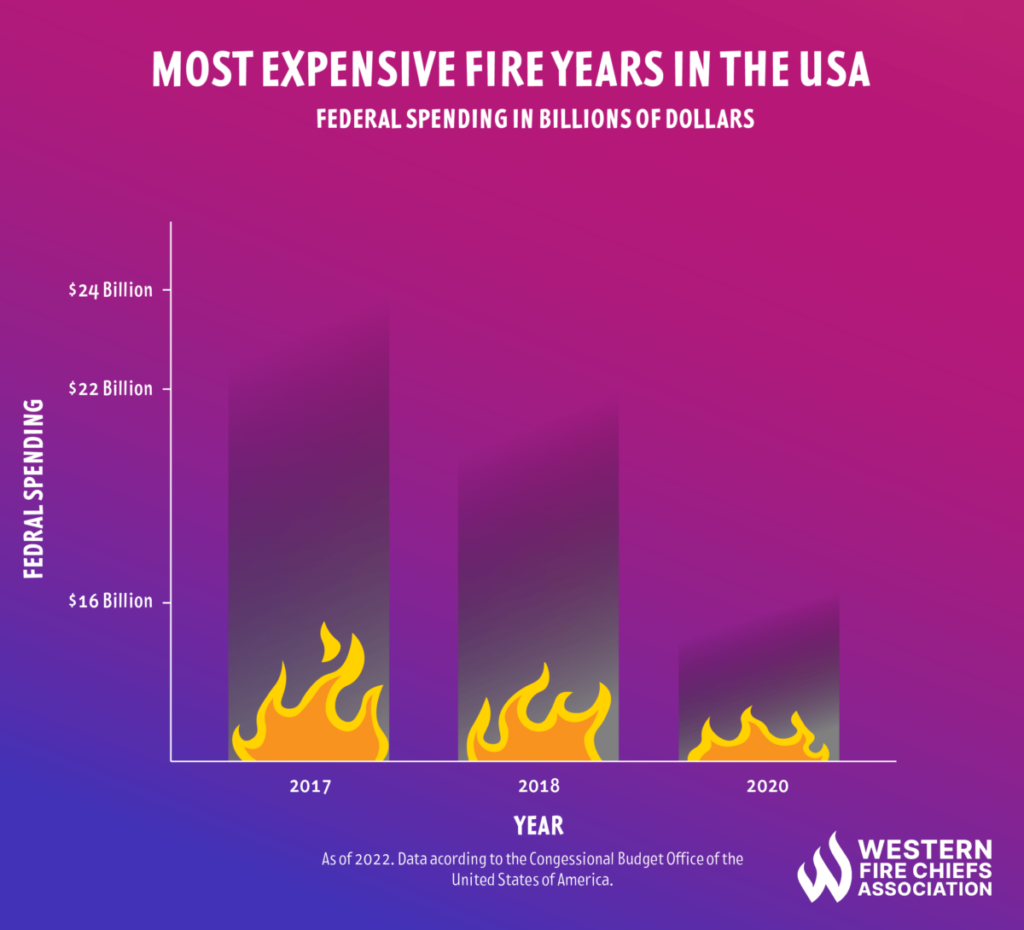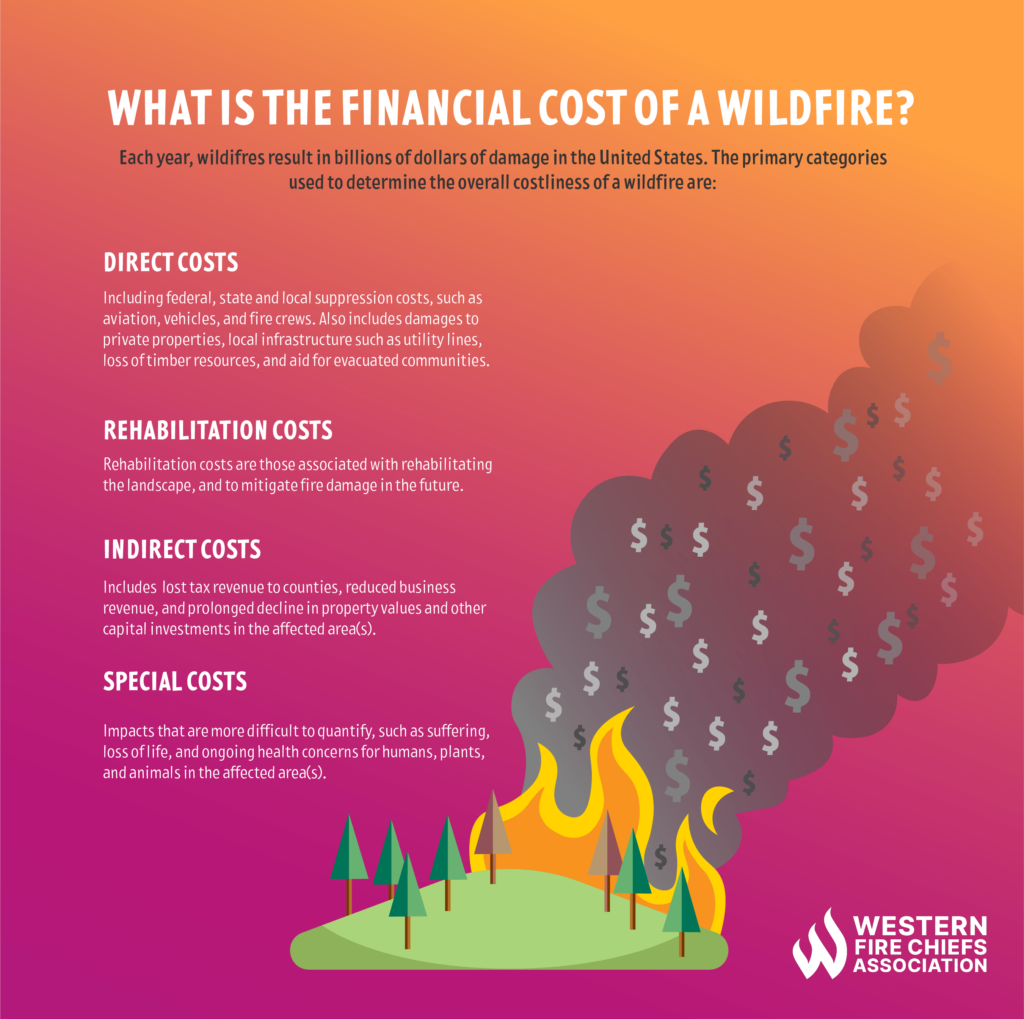Firework Safety Tips: How to Stay Safe
Discover essential firework safety tips to ensure a dazzling display without accidents. Learn how to celebrate responsibly with expert guidance from WFCA.
The cost of a wildfire comes in many different forms. In this article, we'll explore the financial cost burden of a wildfire, and where those costs are incurred.
Published:December 6, 2022
Edited:March 4, 2024
The cost of a wildfire comes in many different forms. In this article, we’ll explore the financial cost burden of a wildfire, and where those costs are incurred.
Wildfires can be hugely destructive, creating an enormous financial burden for affected communities. Wildfires result in billions of dollars of damage each year, a figure that is only increasing thanks to the effects of climate change.1. Suppression efforts are often the first costs associated with wildfires, but this accounts for just a fraction of the true financial burden caused by wildfire. Further costs include rehabilitation costs, indirect costs, plus additional costs that are harder to quantify, such as loss of life, prolonged health issues, and ecological damage.

According to the Congressional Budget Office, federal fire suppression spending on federal lands alone averaged $2.5 billion between 2016 – 2020.2 In terms of damages, 2017 was the largest amount spent in US history, with wildfires causing $24 billion worth of damages. 2018 was a close second, at $22 billion, and 2020 came in third, causing $16 billion in damages.3 It is worth noting that these figures do not include indirect damage costs, such as reduced business revenue, lost tax revenue, and a decline in property value.
Currently, there is no standardized methodology for assessing the total economic impact of wildfire across all verticals (direct, indirect, rehabilitation, and others), but one study estimated that the nationwide impact of California’s 2018 wildfire season totaled $148.5 billion in economic damage.4
The direct costs associated with wildfires include those incurred during and immediately after the fire. This predominantly includes federal, state, and local suppression costs – things like expenditure on aviation, vehicles, and fire crew. Other direct costs include damages to private properties, local infrastructure such as utility lines, loss of timber resources, and aid for evacuated communities.5
Rehabilitation costs are those associated with rehabilitating the landscape to mitigate fire damage in the future. Some argue that immediate emergency rehabilitation should be categorized as a direct cost – given that these costs are incurred days and weeks after the event. But longer-term rehabilitation costs can span many years which is harder to measure. Events such as post-fire flooding can cause additional damage to the environment, as well as the increase in invasive species and erosion.

Indirect costs are costs resulting from the fire that are typically overlooked. They include things like lost tax revenue to counties, reduced business revenue, and prolonged decline in property values and other capital investments. These costs tend to accumulate once the fire has been extinguished and the landscape has started to be rehabilitated.
When calculating the total cost of a wildfire, indirect costs are often left out, meaning the real price tag is an underestimate. Recent estimations of the actual cost of wildfire have ranged from two to thirty times the cost of suppression and immediate resource impacts.6
In addition to the direct and indirect cost of wildfires, there are also longer-term, or ‘special’ costs that are harder to quantify. This includes the suffering of humans, animals, and nature, loss of life, and ongoing health concerns. The impact on human health can be costly, but difficult to account for. Wildfires leave behind toxic debris in the air, soil, and waterways, which can lead to or aggravate chronic health conditions such as asthma and pneumonia, or even result in death, which may manifest many months or years after the event.
A 2017 study led by the Environmental Protection Agency estimated the cost of short-term exposure to US wildfires occurring between 2008 and 2012 that led to premature deaths or hospital admissions at a total of $63 billion. The cost of long-term exposures was an estimated $450 billion.7
Even harder to quantify are the negative impacts on livelihoods and loss of human life, as well as the loss of ecosystem services and aesthetic and scenic beauty. Finally, consideration should also be given to the impact on plants and wildlife.
Western Forestry Leadership Coalition’s, The True Cost of Wildfire in the Western U.S., 2022 Report
Discover essential firework safety tips to ensure a dazzling display without accidents. Learn how to celebrate responsibly with expert guidance from WFCA.
Explore the role of AI in wildfire prediction with guidance from the WFCA. Learn how advanced algorithms and data analytics enhance early detection and response.
Empower your community with a detailed guide on creating a Wildfire Protection Plan. Explore crucial steps and strategies with expert guidance from the WFCA.